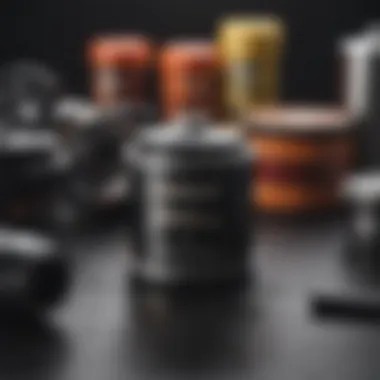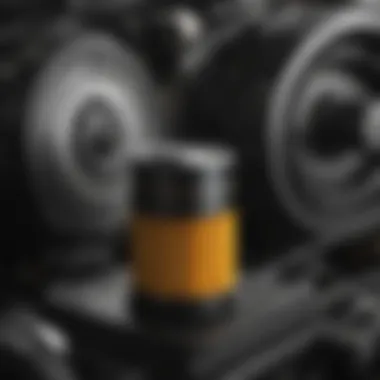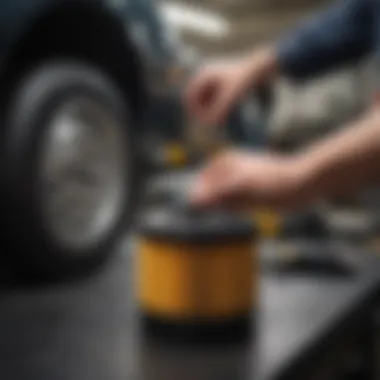How to Change an Oil Filter: Step-by-Step Guide


Intro
Changing an oil filter is an essential maintenance task for any vehicle owner. It is significant not only because it maintains optimum engine performance but also because it extends the vehicle's longevity. This guide is designed to provide a step-by-step approach to changing your oil filter. Understanding this process is crucial for both automotive enthusiasts and average car owners who intend to take their maintenance into their own hands. Getting accustomed to these practical skills can help save costs and also foster a deeper connection with your vehicle.
Regular oil changes and filter replacement have huge impacts on engine health. Ignoring it can lead to poor functioning and costlier repairs in the long run. Familiarize yourself with the necessary tools and procedures we will outline to undertake this task successfully.
Tools Needed
To begin this process, certain tools are essential to ensure a smooth experience. Here’s a breakdown of what you require:
- Oil Filter Wrench: This tool aids in removing the old oil filter securely.
- Socket Wrench: Useful for unscrewing bolts and drains located on the vehicle.
- Oil Catch Pan: Designed for catching old oil during the change process to prevent mess.
- New Oil Filter: Make sure you choose the correct size and type for your vehicle – refer to your owner's manual.
- Engine Oil: Fresh oil according to your vehicle’s spec is vital.
- Gloves and Rags: For cleanliness and avoiding mess while handling oil.
Using quality tools fosters better efficiency and minimal frustrations.
Step-by-Step Procedure
Occasionally, performing this function may appear intimidating for newcomers, but by breaking it into manageable steps, it becomes feasible.
- Prepare the Vehicle: Begin with turning off the engine and ensuring the vehicle is on an even surface. Your engine must be sufficiently cool prior to beginning.
- Raise the Vehicle If Necessary: If needed, use car ramps to ensure easy access to the underside. It’s safer if uncertain.
- Locate the Oil Drain Plug: Regularly found under the vehicle, the oil drain plug should be at the oil pan's lowest point.
- Remove the Drain Plug: Using a socket wrench, remove the plug carefully. Your oil catch pan should be positioned beneath to capture exiting oil.
- Allow Oil to Drain Completely: Wait for some time before moving to the next step so that all old oil drains out thoroughly.
- Remove the Old Oil Filter: With the oil filter wrench, unscrew your oil filter. Be mindful of any residual oil that may still be caught in it.
- Prepare the New Oil Filter: Apply a bit of the new oil onto the rubber gasket of the new oil filter. This simplifies installation.
- Install the New Filter: Screw in the new filter hand-tight. Avoid over-tightening, as this may lead to leakage.
- Replace the Drain Plug: While using your socket wrench, reinsert and tighten the drain plug securely.
- Add New Oil: Open your engine’s cap and pour in the new oil, referencing your owner's manual for the appropriate amount.
- Run the Engine Briefly: Allow the engine to run for a minute. This helps new oil circulate. Check for any leaks beneath.
- Dispose of Old Oil and Filter Appropriately: Always follow local regulations when disposing of and recycling old oil and the used filter.
Importance of Regular Maintenance
Regular maintenance plays a pivotal role in maintaining vehicle efficiency and performance. A car requires systematic check-ups, ranging from fluid levels to tire pressure.
Not solely focused on oil, regular check-ups catch minute issues before they escalate.
“Regular maintenance not only ensures your evohicle's performance, its also adds value and extends its service life substantially.”
Prelims to Oil Filter Replacement
Changing an oil filter is an essential part of vehicle maintenance. Being aware of the significance of oil filter replacement enables car owners and automotive enthusiasts to prolong the life of their vehicles. Not only does this process help in maintaining optimal engine performance, but it also contributes to overall safety on the road. Regularly changing the oil filter limits pollutants and excess contaminants from entering the engine, hence promoting smoother operation.
Ultimately, an oil filter is responsible for keep oil clean and free from debris. This cleanliness supports the engine's ability to operate efficiently. A neglected, dirty oil filter can reduce engine efficiency and raise the potential for mechanical failure. Therefore, understanding the importance of replacing your vehicle's oil filter cannot be understated.
Importance of Changing Oil Filters
Changing oil filters routinely should be a priority for anyone serious about vehicle maintenance. Oil filters undergo wear and tear, collecting particulates over time. If not replaced, a cloggy oil filter might restrict oil flow, leading to an overheated engine or even overheating.
By instilling a regular routine of filter changes, unexpected breakdowns can be avoided. Clean filters allow oil to circulate effectively. This is key for protecting various engine components and ensuring peak performance. Moreover, this preventative measure can spare drivers from spending extra on repairs and replacements.
Frequency of Oil Filter Changes
Knowing how often to change your oil filter depends on a few factors such as the manufacturer's recommendations, driving habits, and oil type used. Typically, it is advisable to replace the oil filter every time you change the engine oil. This usually implies a change interval of 3,000 to 7,500 miles, depending on whether you’re using conventional or synthetic oil.
In addition, different driving conditions can influence this schedule. For instance, frequently driving in stop-and-go traffic can necessitate changing the filter more often. Correct timing for oil changes is crucial because both oil and filter work together to protect your engine.


Regular oil filter changes are a critical aspect of engine maintenance and must not be overlooked, lest the life of your vehicle be compromised.
Tools Required for Changing an Oil Filter
When undertaking the task of changing an oil filter, it is crucial to understand the various tools that will make the process efficient and effective. Selecting appropriate tools facilitates a smoother execution of this routine maintenance task. You may find that having the correct tools not only simplifies the job but is essential for ensuring that the oil filter is compatible with your vehicle.
As you prepare for your oil filter replacement, consider the following Basic Tools and Safety Gear that will optimize your experience and enhance your safety during the procedure.
Basic Tools Needed
Some basic tools are indispensable when changing an oil filter. Not having the right implements can lead to a frustrating experience. Here are the key tools you will need:
- Oil Filter Wrench: This tool is vital for loosening or removing the old oil filter. Without it, you risk damaging the filter or your vehicle’s components.
- Socket Set: A proper socket and ratchet set is necessary for removing the drain plug. Ensure that you have the correctly sized socket to avoid stripping the threads.
- Drain Pan: You will need a drain pan to catch oil as you remove the filter. This step is crucial to prevent mess during the process.
- Towels or Rags: These will assist in cleaning, catching spills, and ensuring that oil does not apply on unintended surfaces.
- Gloves: Disposable gloves protect your hands from oil and dirt. It is recommended to use them for hygiene purposes.
- Funnel: Using a funnel can help in refilling the oil without causing spillage.
Having these essential tools ready can greatly improve your experience. They ensure that each step can be accomplished effectively without unnecessary delays or complications.
Safety Gear Recommendations
Safety should always be a priority while performing automotive maintenance tasks. Below are some recommended safety gear that deserves your attention:
- Safety Glasses: Eyes are vulnerable to splashes that can occur during oil draining or replacing. It is wise to wear safety glasses while performing the job.
- Work Gloves: Beyond protecting from oil, gloves also prevent cuts and grim while manipulating components under the vehicle. Select gloves that are oil-resistant.
- Non-Slip Footwear: The workspace can get slippery. Wearing non-slip shoes helps protect from falls when seated on hard surfaces.
- Mechanic's Kneepad: If you are working low to the ground, these can provide comfort while protecting your knees from the cold or hard floor.
Ensuring that you wear appropriate safety measures allows for both a secure and protective environment while changing your oil filter. Taking precautions can help to provide a far better experience overall, ultimately leading to a successful oil filter change.
”Preparation, including the right tools and safety gear, is half the battle won when it comes to effective automotive upkeep.”
Preparing to Change the Oil Filter
Before diving into the process of changing an oil filter, it's essential to prepare adequately. Proper preparation significantly affects the ease and success of the operation. Without the right steps, you may face difficulties that could complicate or prolong the process. Good planning ensures that you have all necessary tools and information before starting. Let's discuss the critical components of the preparation stage that will set you on the right path.
Vehicle Preparation
Preparing your vehicle is the first and most crucial step in changing the oil filter. Safety is always a priority. Make sure the vehicle is parked on a level surface, with the engine turned off and cool. Engaging the parking brake is also advisable. This measures reduces the risk of the vehicle rolling unexpectedly.
It's useful to gather your tools near the vehicle before starting; this eliminates unnecessary trips back and forth.
- Raise the front of the vehicle if necessary. Using a car jack and jack stands will make access easier, especially for snug filter options. However, ensure they're placed correctly to prevent accidents.
- Confirm the model of your vehicle to locate the filter quickly. Refer to the owner’s manual to find filter specifications and locations; each model may present various filter types.
- Secure the area below the vehicle. Consider placing a drain pan to catch any oil leakage.
These preparations will not only enhance safety but also streamline the entire process of replacing the oil filter.
Oil Type and Specifications
One vital aspect of preparing for an oil filter change is selecting the correct oil type. Not all oils are alike, and knowing specific details helps optimize vehicle performance. The expected oil type and appropriate specifications are typically found in the car’s manual. Here’s what to consider:
- Viscosity Rating: This number indicates the thickness of the oil. Standard ratings include 0W-20, 5W-30 among others. Choosing the right one for your vehicle affects temperature control and engine function.
- Oil Standard: Familiarize yourself with specifications such as API ratings (like API SN) that oil meets.
- Compatibility: Ensure the selected oil type is compatible with the new filter to avoid issues with flow and filtration. Some brands provide proprietary oil along with their filters.


Adhering to the right specifications will support the longevity and efficiency of your engine, avoiding potential costly repairs in the future. Proper preparation paves the way for a successful oil filter change. This initial investment of time and care pays off in better vehicle health and performance.
Step-by-Step Guide to Changing the Oil Filter
Changing the oil filter is a crucial part of automotive maintenance. It ensures the engine operates smoothly. A step-by-step process helps to streamline this task, making it feasible for individuals, regardless of experience. Knowing this procedure empowers vehicle owners. It reinforces the habit of regular maintenance. This flow prevents costly repairs down the line.
Locating the Oil Filter
To replace the oil filter, first, you must locate it. The positioning often depends on the make and model of your vehicle. Typically, the oil filter is under the car near the engine. In some cars, it might be higher up or even hidden. Refer to your vehicle’s manual; it usually carries a diagram indicating where to find the oil filter. Online forums such as reddit.com can provide insights from other owners about your specific car model. Ensure the car is turned off, and allow the engine to cool off to avoid burns.
Removing the Old Oil Filter
Once you have located the oil filter, it is time to remove the old filter. To do this efficiently, you will need an oil filter wrench to gain the leverage required. Before starting, place an oil catch pan under the filter to collect any leaking oil. Turn the filter counterclockwise to loosen it.
Important: Be careful, as the old filter may still contain some used oil. Once loose, continue turning it until it comes off completely. Inspect the rubber o-ring on the old filter for any remnants of it stuck to the mounting surface.
Steps for Removal:
- Ensure safety gear is on, such as gloves and goggles.
- Position the oil catch pan directly underneath the oil filter.
- Position the oil filter wrench around the filter and rotate counterclockwise.
- Once removed, place the filter upright in the catch pan.
Preparing and Installing the New Oil Filter
After removing the old filter, it's time to prepare the new one. Before installation, smear a bit of fresh oil on the rubber gasket of the new oil filter. This step helps form a seal, preventing leaks when the engine runs. Next, align the new filter with the mounting point. Hand-tighten it by turning it clockwise until snug, but avoid overtightening, which may develop damage.
Installation Steps:
- Ejnure your hands are dry and clean.
- Grab the new filter and wet the gasket lightly with fresh oil.
- Position the filter over the mounting thread.
- Assume a firm grip and turn clockwise until snug, usually a three-quarter turn.
- Store the old filter for proper disposal later.
With careful completion of these steps, you ensure the oil filter is fitted properly. Updating your filter routinely maintains the optimum performance of the car, keeping it efficient on the road.
Post-Installation Steps
After you have successfully changed the oil filter, there are essential steps to follow to ensure everything operates correctly. Post-installation steps are critical as they help to confirm that the replacement was done correctly and that your vehicle functions securely without issues after the oil filter change. Neglecting these steps may lead to serious mechanical problems and possible damage to your engine.
Checking for Leaks
Once the new oil filter is installed, it's necessary to check for leaks. It is common for small oil leaks to occur if the filter isn't sealed properly.
- Start the Engine: After the oil filter is changed, turn on the engine. Allow it to run for a few minutes. This time enables the oil to circulate and fill up the new filter.
- Inspect Around the Filter: Look closely at the area where the new oil filter is attached. If you notice any wet spots, it indicates a leak.
- Monitor for Oil Puddles: After turning off the engine, examine the ground beneath the vehicle for any signs of leaking oil. Small puddles under your car mean your oil filter might not be correctly attached.
Regularly checking for leaks can save you from significant repairs in the future. It ensures engine efficacy and longevity.
If leaks are present, you should recheck the installation of the oil filter and make necessary adjustments. If the filter seems to install well and you still detect leaks, replacing the filter could be necessary.
Disposing of Old Oil and Filters


Proper disposal of used oil and filters is an often overlooked yet crucial aspect of the oil changing process. Used oil can contain harmful chemicals that can negatively affect the environment. Therefore, it's imperative to dispose of these materials responsibly.
- Reduplication with Local Regulations: Check any local laws or recommendations regarding the disposal of used oil and filters. Many places have specific guidelines that help keep the environment safe.
- Use a Trusted Recycling Center: Most communities have recycling facilities where you can take your used oil and filters. Consider using places that are NCMA certified or licensed under state and local regulations.
- Utilize Containers: Ensure you store old oil in a plastic container with a tight seal. Avoid mixing it and keep it out of reach of children and pets. Oil must be in a container labeled clearly to avoid conflicts.
By disposing old oil and filters properly, you participate in maintaining a healthy environment and help prevent land contamination.
In summary, the post-installation steps form an integral part of the oil filter changing process. Checking for leaks ensures operational safety, while responsible disposal practices work to benefit the environment.
Common Challenges and Solutions
Dealing with oil filter replacement can occasionally involve certain challenges. Understanding these problems and their resolutions not only eases the process but can also prevent damage to your vehicle. Knowing how to address common oil filter issues is crucial for returning your maintenance tasks back to an efficient routine.
Stuck Oil Filters
A stuck oil filter is one of the common issues faced by many, especially if it has been over-tightened or if a quick change interval was neglected. Oil filters should be hand-tightened, yet sometimes they bind to their threads.
How to Address Stuck Filters:
- Apply Breaker Bar: Using a breaker bar can provide extra leverage alongside an oil filter wrench to loosen the filter.
- Lubricate Threads: Before attempting removal, applying a small amount of penetrating oil on the threads can help reduce friction and loosen any buildup.
- Tap on the Filter: Gently tapping around the edge of the filter with a rubber mallet may help to disturb the seal.
Be cautious with tools that may damage the oil filter beyond repair or leave fragments in the foster. It is better to proceed with small adjustments and be patient.
It’s always advantageous to prevent issues rather than solve them. Using only hand-tightening can make an oil filter's future removal much less troublesome.
Choosing the Right Oil Filter
In selecting the right oil filter, there are several considerations to take note of. Not all filters are created equal, and improper selection can lead to inefficiencies.
Key Considerations for Choosing an Oil Filter:
- Compatibility with Your Vehicle: Always ensure the filter matches your vehicle's make and model for optimal performance.
- Type of Oil Filter: Various types like cartridge or spin-on filters cater to diverse engine requirements. Knowing the appropriate type balances quality and compatibility.
- Manufacturer Recommendaion: Consulting your vehicle’s manual or reputable resources can provide insight into preferred brands and their specifications.
- Filter's Filtration Rating: Look for filters that meet or exceed industry standards, ensuring the filter captures impurities effectively.
By taking the time to select the appropriate oil filter, you greatly improve the functioning and longevity of your engine. Thus, it is not just about changing oil filters, but enhancing overall vehicle maintenance.
Finale
Changing your oil filter is a crucial aspect of vehicle maintenance. In this article, we have examined the significance of this task, detailing tools required, procedures to follow, and common challenges you might face.
Recap of Key Points
This guide covered several essential areas:
- Importance of Changing Oil Filters: Oil filters play a vital role in keeping the oil clean and ensuring engine longevity.
- Tools and Preparation: Necessary tools were outlined alongside safety gear, emphasizing a proper approach to the task.
- Step-by-Step Process: The detail-rich instructions on locating, removing, and installing the oil filter provide a straightforward understanding.
- Post-Installation Checks: Techniques for checking leaks and disposing of old filters highlight responsible vehicle upkeep.
- Common Challenges: Solutions to stuck filters and filter choice equip readers with necessary troubleshooting skills.
These elements together form a complete picture of changing an oil filter correctly. Regularly doing so can markedly improve engine performance and longevity while providing the essential preventive maintenance your vehicle requires.
Importance of Regular Maintenance
Regular maintenance, including timely oil and filter changes, should not be overlooked. Neglect can lead to significant mechanical issues that often result in unnecessary and expensive repairs. Keeping the oil filter clean prevents contaminants from entering the engine, promoting efficiency and reliability.
Proper maintenance ensures that components are functioning as intended, which ultimately improves fuel efficiency. Car owners should prioritize this practice to extend vehicle life and avoid future headaches. Regular checks and changes can save time, minimize long-term costs, and keep your driving experience smooth and pleasant.
Remember, maintaining your vehicle is not just about repairs; it is about performance, safety, and saving money in the long run.



